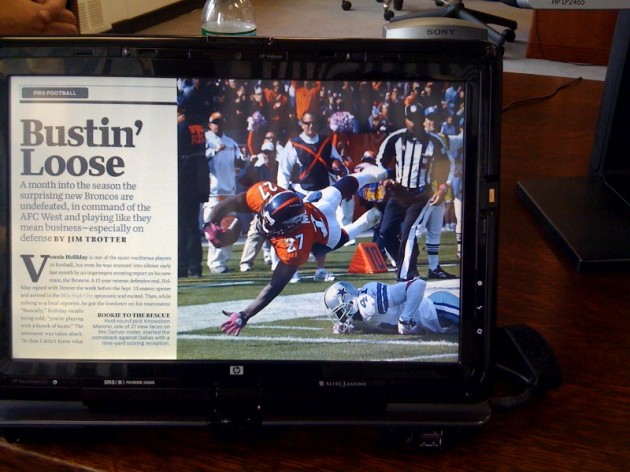The magazine industry is falling over itself over a new shiny object. It wants to remake its product for a new class of digital tablets with color screens and touch screens. Today, a group of big publishers—Condé Nast, Time Inc., News Corp. Hearst, and Meredith—announced a joint venture to create standards for digital magazines to be read on tablets, e-readers, Web phones, and the like. The consortium will also create a digital newsstand to sell electronic copies of its magazines. These will be more like downloadable apps than Websites—think of it as an App Store for Magazines, where you can find and download magazine issues and subscriptions in app form.
The existence of this App Store for Magazines (and newspapers, presumably) raises a big question. Why are these print publishers reinventing the digital wheel? A popular app store already exists. It’s called iTunes. And people don’t mind paying for apps there. By creating their own app store, the magazine publishers can avoid paying Apple its 30 percent cut of sales. But that’s not the real reason.
The real reason they want their own store is the customer data. Magazine companies may look like paper companies, with a little art direction thrown in. But at their core, magazine companies are database companies. The way they make money is by knowing who their readers are and marketing to them by where they live and who they are. For nearly every subscriber, they have a credit card number. And they have whole departments which do nothing but massage the data to figure out who to target for advertising purposes and where the profits are. I’ve seen this machine in action. The database people hold the secret levers of power inside magazine companies.
If they cede their digital magazines to Apple, then they lose those credit card numbers and all of that customer data. This joint venture is all about keeping that direct, paying relationship with consumers. It is about controlling the data.
And just because the magazine companies have their own storefront does not mean they cannot offer their mag apps on iTunes. They can bypass Apple’s tollbooth by creating free iPhone (or future iTablet) apps which direct people to the their storefront for payment. The digital newsstand could also have apps for other tablet devices, as well as Android, Blackberry, and Palm phones.
Of course, there are several drawbacks to this approach. This workaround will require people to type in their credit card numbers again to yet another online store, and many people will simply decide its not worth it when prompted. The other issue, as with any third-party digital marketplace, is that it is not fully integrated with the device and so won’t be as appealing as a native app.
We’ve already seen what some of these Mag apps will look like, and they don’t look bad. Last week, Time Inc showed off a demo of its Sports Illustrated tablet reader (see above or videos here). Condé Nast has its digital demo of Wired. And Hearst is working on an internal project called the Skiff reader. All of these may influence the e-reader standard which the still-nameless joint venture will settle upon, or maybe it will come up with its own iteration.
The danger is that it will kill off the much-needed experimentation going on at each of the individual publishers before anyone is really able to figure out what a digital magazine should look like. But it should be able to support different variations. This joint venture is really more about the backend—about creating a digital store where everyone’s mag app can be sold side by side just like paper magazines on a rack. What’s inside can still be different.
Still, joint ventures among intense competitors don’t have a great history of success. If any one of the publishers doesn’t like the e-reader standards the consortium comes up with or the storefront, there is nothing stopping it from simply going its own way. Just because the media companies may be throwing a few million dollars into the project doesn’t offer it much protection. It likely will be seen by the operational executives as an outside project they don’t need to pay much attention to—unless it starts generating some serious cash for their own operating units. For that to happen, they need a great tablet reader to put it on that isn’t owned by Apple, or at least isn’t tied to its store.
